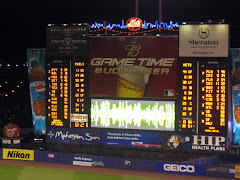
As one baseball season comes to an end, the Rotisserie Hot Stove League kicks in big time. And you have to make some early decisions in your keeper leagues. Each is different and the guidelines affect your thinking, but here is what I have been tossing around so far.
Say you play in a keeper league with a $260 salary cap and a $350 in season salary maximum for all your players, which includes 10 reserves.
You spent the season trying to win your league’s pennant, and you traded away star rookie prospects like a Cameron Maybin or Travis Snider, whose salary was a buck, for a Josh Beckett or an AJ Burnett, who went for up to $25. The season has ended, and now your team’s total salary is at $349. You are sitting with guys like Vladimir and Jason Bay and Lance Berkman at 35 bucks plus. No way can you keep or protect all these guys.
What do you do?
Rule Number one: Dump Salary.
If your league’s trading season is open, you had better start biting the bullet and dealing your high priced sluggers and starters for something. Of course, it depends on the number of keepers your league has. If it is a small keeper league, then those guys are horsemeat anyway. But if you play in a deep keeper league and the team in 19th place needs a slugging bat, maybe you can deal a disappointing and high priced Lance Berkman for Carlos Gomez, and the potential of steals he brings to Milwaukee.
Rule Number two: Trade Down.
Every team needs a solid ace in its core of nine or ten pitchers, someone who can stabilize your pitching corps with consistently good outings. I do not mean a Jon Garland. I mean a Dan Haren, some guy you may have to pay 30 bucks for and who will dutifully post a strikeout an inning. I think you go for the strongest arm with the least injury history when it comes to betting the farm on a pitcher. Every pitch is a toss away from TJ surgery, but it seems sensible that if you have to bet, a guy like Josh Beckett, who never misses a start, is a good risk. But if you traded during the season so as to land Beckett and Burnett, and both are 28 bucks each, you had better deal one of them.
So in a league with deep keepers, dealing Josh Beckett at $28 bucks may be worth acquiring Jon Niese, a Met strikeout artist in the minors, at $1. Maybe the last place team is sitting on a $1 dollar 14 game winner in Ric Porcello, who won’t give you strikeouts, but may give you era, whip, and victories. You gotta’ go for it. It may aggravate fellow league owners, but you were going to lose Beckett in the draft, and now you are acquiring a likely starter..
Rule Number Three: Give Up More than You Get.
Another way to play the game in the offseason is to overwhelm your competitor with an offer which in fact helps him and seemingly hurts you. If you need to get down protecting say 15 players at $200, it will not help you having a dozen quality players at $20 bucks each. So don’t be afraid to do a giveaway which benefits your opponent if it gets you a low priced bat. Say you are sitting on a corner bat like Mike Lowell at 15 and Josh Beckett at 28 and there is no way you can pay both $43. Offer them and a rookie to a lower echelon team for a $5 Andy La Roche in the hope he emerges. Is that fair value? Of course not. Still, in a league based on salaries, you have to do that. Would a rebuilding team bite? Only if they need an ace. But you take your shot.
In one league I am in, we do not use salaries, but we really limit the guys you can protect, and we play with a small roster. One dude saw his team was out of the money and he finished last in the league but first in trading. His ingenious method was to steadily improve other teams in trades by offering multiple talents to acquire their best player, hoping to lock them away as part of a protected cast for the following year.
So here, he said, take Brian Roberts, Nate McClouth, and Justin Morneau. Just give me Albert Pujols. Take Roy Halladay, Mark Texeira, Jimmy Rollins. Just give me at all costs Chase Utley.
The season ends and he gets to protect six players next year, and each are the best at their position. Not to mention, he has the first draft pick. Thus, in a keeper league, a two year plan is not out of the question. This guy has a formidable team going into next year’s draft. We only play 17 players in a 16 team league, and his top 6 are in the top 15 in baseball.
Rule Number Four. Score A Solid Veteran
The most fun is being the guy to take the next rookie at 1 buck who delivers 19 dollars worth for you, and becomes a star. So no one wants the 38 year old Casey Blakes and Mike Lowells whose numbers are consistent season after season, but are heartbreaking injury risks. Chances are they will be excellent and cheap late round selections next season. If your league uses toppers, a certain number of guys you get to keep if you bid a buck higher than anyone else, why not trade for one of them as a safety valve for your draft next Spring?
How many teams and owners let Aaron Hill in Toronto escape their eagle eye last season? He was off to a running start in 2008 when he went down with a season ending injury so he was off everyone’s radar, and wound up putting up huge numbers in 09. Trust in medicine. Based on how he started off in 09, you have got to believe a healthy Rickey Weeks can put up the numbers he started to put on the board last April. Remember that an owner seeking to dump a New York Yankees hurler named Wang may be tossing a guy who won 38 games in two seasons.
Rule Number Five. Grab Some Guys in Limbo
A week ago, no one knew if Carlos Gomez had a job. Now he may start in Milwaukee. His value has just soared.
Jeremy Hermida may be a fourth outfielder, but in the Boston lineup with that short rightfield porch and a DH slot available, the guy could blossom in Boston. At Fenway, his value has just soared.
As the season ends, Garrett Atkins has no job, and a team may dump him. Imagine how his value would soar if he was inserted into the Phillies lineup to replace Feliz? Look around for those guys who owners are nervous about keeping and may fool everyone. The Dodgers grabbed George Sherill as an 8th inning guy for their stretch run but no owner may want to pay his salary if he is not a closer. What happens if LA does not keep him and he winds up as a closer in another city? Look for that type of player, like a Hideki Matsui. He is going to hit 25 homers somewhere, but right now you are in a good bargaining position to grab him as the Yankees ponder whether to go with youth or re-sign the World Series Hero. Maybe his value soars if he signs anew and his roster spot gets locked in.
As I said, these rules are not etched in stone because there are numerous variants based on your league’s requirements and salaries and keeper provisions. But it helps to get through the next four months when the only excitement is Rotoworld’s posting of who gets untendered, busted, or traded.
As I said, these rules are not etched in stone because there are numerous variants based on your league’s requirements and salaries and keeper provisions. But it helps to get through the next four months when the only excitement is Rotoworld’s posting of who gets untendered, busted, or traded.


























No comments:
Post a Comment